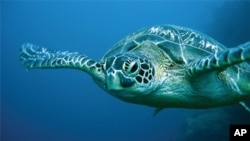What makes for a happy turtle? Hard to say, but a good start is probably warm water, plenty of food to eat, and an environment that's not fouled with raw petroleum.
That's exactly what a number of wild sea turtles are finding at the Audubon Institute's Center for Research of Endangered Species in New Orleans Louisiana - one of several facilities taking care of the animals caught up in the BP oil spill.
"I like to refer to us as the sea turtle MASH unit for the oil spill for Louisiana," says Michele Kelley, the sea turtle and marine mammal stranding coordinator for Audubon. Kelley says that after the sea turtles have been rescued, they are cleaned and treated - including what's called a 'gavage' of mayonnaise and cod liver oil that will help purge their digestive system of oil.
The vast majority of the sea turtles treated at Audubon survive the ordeal. But their rescue is not a short term project.
"We don't know the long term effects of hydrocarbons on sea turtles. We're writing the book, we're living the book as we move right now," says Kelley. "Their electrolytes and glucose levels can plummet several days after, so we have to constantly take those animals out, do their blood draws, retreat them, hydrate them, make sure they're okay. So, the treatments continue for a month."
Researchers like Kelley may be learning new techniques and lessons, but the ultimate goal of all this work is to get the turtles back into the wild - into water cleaned of oil and an environment not suffering environmental degradation from the spill. And that may be a tall order.
"There are five species of turtles in the Gulf of Mexico," says Barbara Schroeder, Sea Turtle Coordinator for the National Oceanic and Atmospheric Administration in Washington DC. "We have concerns about all of them. Four of them are endangered and one - the loggerhead - is currently threatened, but proposed for endangered listing. So we have five of the world's seven species inhabiting the Gulf of Mexico."
Of all the endangered species, the Kemps Ridley sea turtle may be the most threatened by the Gulf oil spill, because its only home is in the Gulf and parts of the Atlantic Ocean.
"With a catastrophic event like this - in terms of the species globally - it is in a little bit more precarious position because it only occurs in a more restrictive place and that happens to be where the oil spill has occurred," says Schroeder.
All those working in the Gulf agree that it's crucial the endangered turtles are returned to the Gulf as soon as possible. Schroeder says many of these turtles picked up in the Gulf are at a stage where they are ready to move into near shore waters.
"The good thing about the size of these turtles is that we have options for where to release them. They don't have to go back out exactly where they came from, where the potential for oil still exist and we're still seeing it in the convergence areas. But we have an option to release them in near shore areas that were never oiled."
Still, some turtles may find themselves swimming back into the oil-polluted waters of the Gulf - especially the Kemps Ridley. And that, says the Audubon Center's Michele Kelley, is the greatest concern.
"The southern tip of Texas and the northern coast of Mexico is where they generally go and nest and lay their eggs. So, again, if we release them, the mechanism in their brain says swim right back through it."
The long term effects of the massive oil spill are unclear, as is just how much oil remains in the water. Even less certain is how the Gulf's wildlife will respond to their changed waters.
You can watch all of Rebecca Ward's "Going Green" video reports by clicking here.





